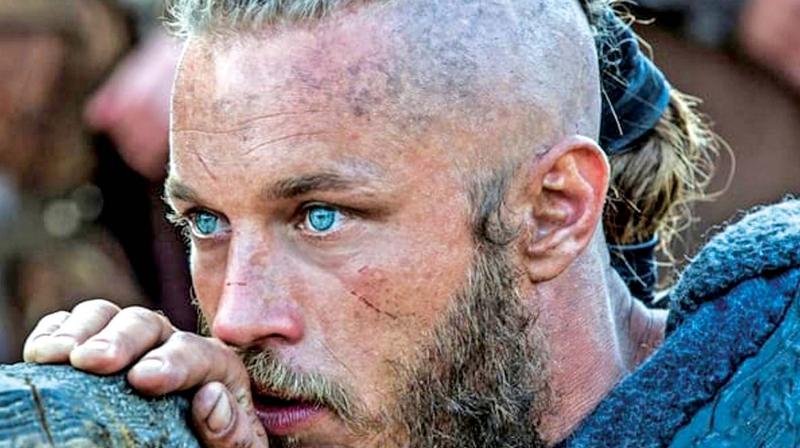When sons become more famous

Vikings season 5 airs every Tuesday at 10 PM only on AXN. The Season is all about how political allegiances are constantly shifting, treaties and allegiances are being made and broken, and everyone is following their own agendas. In terms of storyline, a lot of stuff happens in this season, which is pretty accurate in terms of how Viking society actually operated. Screenwriter and producer Michael Hirst shares his experience and reveals details about the much-awaited Season 5 of Vikings in this interview.
HOW DID YOU BRIDGE SEASON 4 AND 5?
A. Up to end of 4th season, we’ve been locked into world of Ragnar’s family so there’s been limited storylines, one or two basic storylines that people get into. In terms of big adventures, until now, we have only been to France, but with Season 5 we start expanding our worlds. Season 5 starts with the beginning of the disintegration of Ragnar’s family and the great army. The characters become much more ambitious and venture out to the Mediterranean and Iceland. Brothers split up and form different allegiances and begin absorbing more of world around them. In Season 5, the series continues to expand and build, showcasing more of the sons. I always said from beginning that show was not just about Ragnar, but about Ragnar and his sons. In fact, in many ways his sons became more famous than Ragnar.
BISHOP HEAHMUND - HOW MUCH RESEARCH DID YOU PUT INTO HIM AND DID YOU HAVE JONATHON RHYS MEYERS IN MIND TO PLAY HIM?
A. The issue was how do I find a Saxon warrior who is equivalent to Vikings in terms of charisma and reputation. At beginning of S5, the king is in waiting, Aethelwulf in exile, Alfred is ill and possibly dying. The wheels are coming off the Saxon empire in Wessex, so I spoke to my historical advisor and said we need to find someone who can represent the Saxons and he suggested a warrior bishop. These were men who were the precursors to the Knights Templar, genuinely religious men who often were bishops, but also fighters. When we found Bishop Heahmund, a historical figure who was a warrior bishop, I had found a Saxon warrior that could theoretically stand up to Ivar and Bjorn and other Vikings.
Someone suggested Johnathan Rhys Meyers, which was brilliant because, like Bishop Heahmund, he is passionate and intense and I someone in this role that had that intensity. I wanted to show pagan fundamentalism - for audience to understand that paganism was a real religion and that people believed it very deeply. It meant a lot and explained the world to the Vikings. I think I was getting that message across.
WHAT ATTRACTED YOU MOST TO THE IDEA OF EXPANDING THE SHOW INTO OTHER PLACES LIKE ICELAND?
A. I always knew I would take the series to different worlds. I always know I would take the show to France, for instance, because of the famous battle where the Vikings attacked Paris. If you’re working on something set in Dark Ages, inevitably means not as much material about that for that era than say the Tudors. But if there’s anything real then I want to use it. I want to keep pushing boundaries of story and Viking experience into the world as they did. That’s why the show is so meaningful to people around the world because Viking influence reached so many places. Considering
how small these countries are, the impact on world is staggering.
WHAT IS THE BIGGEST CHALLENGE OF YOUR JOB?
A. The biggest challenge is to take what I know historically and get our production to reflect it on the screen. They need to show size because we don’t want to do that with visual effects, everything starts with real things. Our actors fight, row, ride horses and we add visual effects, but how do we show that the Vikings reach is now extensive? You have to go to different places, like Iceland and persuade audience that the places are real.
WHAT WAS IT LIKE FILMING LAST SCENE WITH TRAVIS?
A. My memory is of Travis [Fimmel] suspended in a cage in the mountains in Ireland, in pouring rain, howling wind, in winter, with everyone freezing cold and Travis hitting the sides of cage shouting “I HATE MICHAEL HIRST!!!” It was an emotional moment.
THE SUPERNATURAL IN THE SERIES IS INTERESTING, AS YOU NEVER FEEL AS A VIEWER THAT IT IS TOO FANTASTICAL. WAS IT HARD TO STRIKE THAT BALANCE?
A: Yes, because I don’t like fantasy, but I did want to show that Vikings believed that gods were among them and they were living presences. When we show Odin on the battlefield in the first episode, we show him because that’s what Vikings believed, that Odin was on the battlefield with them. But I didn’t want to do that too much because it had to be real. I did have advantage that gods were shape shifting, but there’s a fine line. In Season 5, when Floki goes to Iceland and sees gods, you see it because that is what he believed, he believed that he found a world where the gods lived. If you see a crow or a raven, maybe it’s a god. My sense is that Vikings see landscapes as living things more so than we do, they see more signs than we do. But when Floki goes to Iceland, it is perfectly possible Floki is mad because everyone he has loved has died. It’s an amazing scene when he says goodbye to Ragnar and Helga - it’s easy to think that’s in his head.

